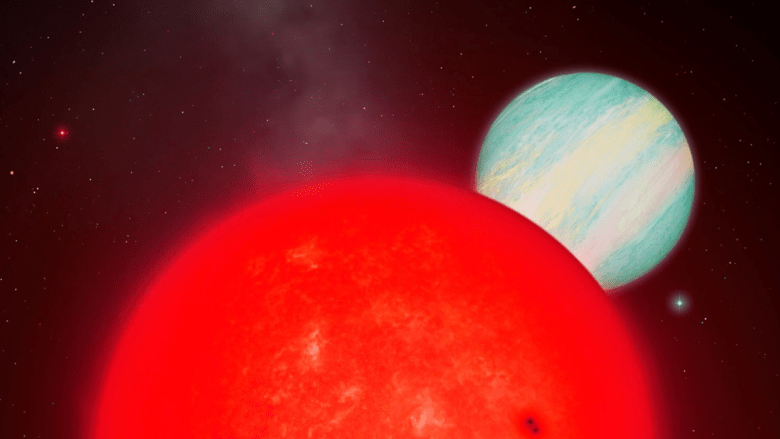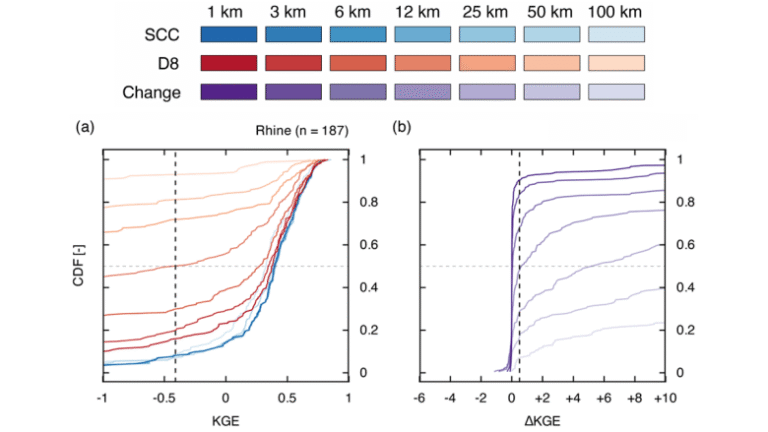

If astronomers have learned one lesson from 6,000 or so confirmed exoplanets, it’s to expect the unexpected. Even so, a giant planet orbiting a red dwarf star recently caught them by surprise. It is the largest planet relative to its host star yet discovered, and it defies the leading theory of giant-planet formation, according to a new study.
TOI-6894 b orbits an M dwarf star roughly one fifth the size and mass of the Sun—60% the mass of the next-smallest star with a giant planet. TOI-6894 b is the size of Saturn and half its mass. The planet is 40% the diameter of the host star, making it by far the highest planet-star size ratio yet seen.
“Because the star is so low mass, based on what we currently understand about planet formation and protoplanetary disks, we wouldn’t have expected it to be able to form a gas-giant planet,” said Edward Bryant, an astrophysicist at the University of Warwick in the U.K. and first author of the study, published in Nature Astronomy.
The planet was first detected by the Transiting Exoplanet Survey Satellite (TESS) in early 2020 and confirmed with additional observations over the following 3 years. TESS looks for the dip in a star’s brightness that occurs when a planet passes between it and Earth, blocking some of its light.

Bryant and his colleagues scoured observations of 91,000 stars in the TESS catalog to determine the frequency of giant planets around low-mass red dwarfs, which are the smallest and faintest stars in the galaxy and the most common. They reported the discovery of several such planets in 2023.
The team’s new analysis shows that the transits of TOI-6894 b are record breakers, reducing the star’s brightness by 17% and hinting at how large the planet is relative to its star. The transits also show that it orbits every 3.37 days.
The follow-up observations with ground-based telescopes measured changes in the star’s radial velocity—back-and-forth “wobbles” in its motion caused by the planet’s gravitational pull that revealed the planet’s mass.
A Special Case?
The leading theory of giant planet formation, called core accretion, posits that such worlds form early in a star’s lifetime, when it is still encircled by a protoplanetary disk—a wide disk of gas and dust that comprises the raw building materials for planets. Heavier materials coalesce to form larger and larger bodies, eventually creating a core that can be several times the mass of Earth. When the core grows large enough, it gobbles up the surrounding gas, building a layered giant planet similar to Saturn or Jupiter.
“It’s a surprise to find a giant planet around such a tiny star because we just didn’t think there would be enough material there.”
“The total amount of heavy material in the disk determines how big of a core you can make,” said Joel Hartman, a research astronomer at Princeton University and a member of the study team. “It’s a surprise to find a giant planet around such a tiny star because we just didn’t think there would be enough material there.” Some studies, he added, have suggested that stars less than about one third the mass of the Sun should not be able to form giant planets at all.
“Theorists who model planet formation [with core accretion] are not able to create planets like TOI-6894 b,” said Emily Pass, an astrophysicist at the Massachusetts Institute of Technology who was not involved in the study. “So the question becomes, Are planets like TOI-6894 b special cases that formed in a different way, or does our entire model of giant planet formation need a revision?” Pass explained. “Understanding the occurrence rate of [such] planets will help test the various possibilities.”
Hinting at the Formation Mechanism
One possibility is a modified accretion mechanism, in which the growing planet hoovers up both heavy materials and gas simultaneously, forming a more mixed world.
“None of these theories can really explain this planet.”
Another possibility is direct collapse. “Instead of the core being built from the ground up, the disk fragments under its own self-gravity and directly collapses,” Bryant said. “If the disk becomes unstable in the right way, you can form giant planets around these low-mass stars. The problem is that some of the simulations predict that you would only form planets that are much, much more massive than Jupiter, which would be many times more massive than this planet. So none of these theories can really explain this planet. We’re really limited by our understanding of protoplanetary disks,” he said.
Hints of the planet’s formation mechanism may be found in its atmosphere, which is scheduled for study in the next year by the James Webb Space Telescope (JWST). As the planet passes in front of the star, starlight shining through the atmosphere will reveal its composition.
“We should be able to tell the difference in whether a planet formed from direct collapse versus core accretion by looking at the atmosphere’s metallicity,” which is the makeup of elements heavier than hydrogen and helium, Hartman said. “In the gravitational instability case, all the materials collapsed together, so the elements should all be mixed together. In the core accretion model, all the heavy elements should be in the core, with a gaseous envelope on top of it.”

Because of the large transit signal, TOI-6894 b should be “amenable” to additional ground-based studies, Hartman said, although none are currently planned. “We’ll wait and see what JWST tells us,” Bryant said.
—Damond Benningfield, Science Writer
Citation: Benningfield, D. (2025), A new exoplanet resets the scale, Eos, 106, https://doi.org/10.1029/2025EO250235. Published on 30 June 2025.
Text © 2025. The authors. CC BY-NC-ND 3.0
Except where otherwise noted, images are subject to copyright. Any reuse without express permission from the copyright owner is prohibited.


